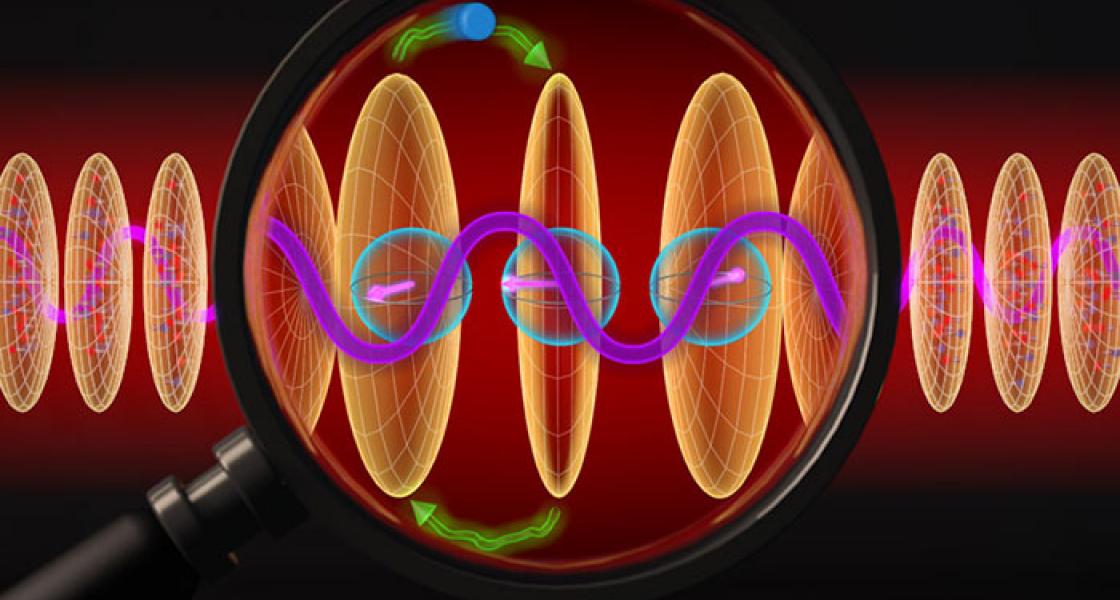The Rey and Ye groups are in the midst of an extended collaboration on using the Ye group’s strontium (Sr) lattice clock for studies of spin-orbit coupling in pancake-like layers of cold Sr atoms. Spin-orbit coupling means an atom’s motion is correlated with its spin. It occurs in everyday materials when negatively charged electrons move in response to electromagnetic fields inside a crystal. By making cold neutral atoms behave as charged particles, it will be possible to better understand the behavior of electrons in solids, something that is essential for developing improved quantum materials and technologies such as spintronic devices, which use spins rather than electric charge to carry information. Additionally, an in-depth understanding of spin-orbit coupling is necessary for advancing our fundamental understanding of modern quantum science.
A new theory study by the Rey group has outlined the many advantages of the Ye group’s Sr-lattice clock for experimental spin-orbit-coupling studies. The clock consists of individual two-dimensional “pancake” layers of about 10 to 100 identical Sr atoms. However, the atoms in different pancakes are not identical because the clock laser “talks” to them differently. After “talking” with the laser, pancakes of identical atoms differ from one another in phase. As a result, if individual Sr atoms tunnel from one layer to another, they can readily be identified as “different” and will collide as nonidentical quantum particles. Any frequency differences associated with their energy and motional states can be detected with the exquisitely stable clock laser. However, quantum tunneling doesn’t normally happen in the clock because the layers of atoms are held inside a deep lattice.
With this understanding in mind, the theoretical study laid out an approach for using the Sr-lattice clock to better understand spin-orbit coupling. First, by decreasing the lattice depth, it would be possible for atoms to tunnel between the layers. At the same time, the clock laser would be able to drive the atoms between different electronic states. Together, these two processes would cause the atoms to move in a circular pattern, emulating the circular motion of charged electrons in a magnetic field.
Second, the theorists predicted that spectroscopy performed with the clock laser would be able to resolve the momentum of individual atoms in specific layers and “see” the atoms collide when they move between layers. Third, they proposed a way to control atomic transport, including predicting a way to modify this process by controlling the atomic collisions. Finally, they showed that these experimental investigations would be possible at current operating temperatures of one of the Sr-lattice clock in the Ye labs.The researchers responsible for this intriguing analysis included research associate Michael Wall, graduate student Andrew Koller, former graduate student Shuming Li, former research associate Xibo Zhang (now at Peking University in Beijing), former visiting fellow Nigel Cooper (now at Cavendish Laboratory in Cambridge, UK), as well as Fellows Jun Ye and Ana Maria Rey.
The theorists are excited about upcoming tests of their ideas with the Ye group’s Sr-lattice clock. Because of the clock’s ultrastable lasers, the experimentalists will be able to observe the Sr atoms for a very long time––long enough to observe the combined effects of atomic interactions and spin-orbit coupling. In the process, both theorists and experimentalists are looking forward to discovering new and as-yet-unpredicted aspects of spin-orbit coupling. At the same time, they hope to better understand how to use cold atoms as electron analogs.––Julie Phillips



 The Physics Frontiers Centers (PFC) program supports university-based centers and institutes where the collective efforts of a larger group of individuals can enable transformational advances in the most promising research areas. The program is designed to foster major breakthroughs at the intellectual frontiers of physics by providing needed resources such as combinations of talents, skills, disciplines, and/or specialized infrastructure, not usually available to individual investigators or small groups, in an environment in which the collective efforts of the larger group can be shown to be seminal to promoting significant progress in the science and the education of students. PFCs also include creative, substantive activities aimed at enhancing education, broadening participation of traditionally underrepresented groups, and outreach to the scientific community and general public.
The Physics Frontiers Centers (PFC) program supports university-based centers and institutes where the collective efforts of a larger group of individuals can enable transformational advances in the most promising research areas. The program is designed to foster major breakthroughs at the intellectual frontiers of physics by providing needed resources such as combinations of talents, skills, disciplines, and/or specialized infrastructure, not usually available to individual investigators or small groups, in an environment in which the collective efforts of the larger group can be shown to be seminal to promoting significant progress in the science and the education of students. PFCs also include creative, substantive activities aimed at enhancing education, broadening participation of traditionally underrepresented groups, and outreach to the scientific community and general public.